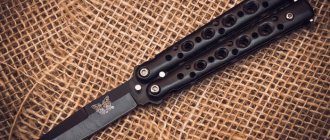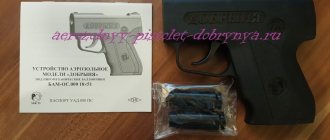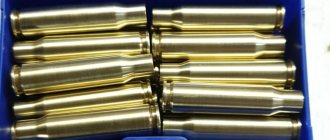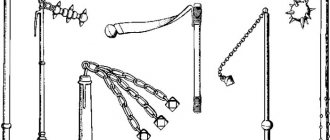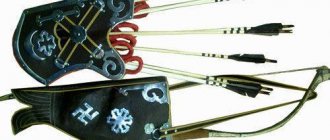Let's find out what is possible and what is not possible when carrying and storing knives from the point of view of Russian legislation, especially since in recent years there have been quite a lot of changes in this area.
Simplified in Russia, knives are divided into two categories, these are:
- knives that are not edged weapons;
- knives that are edged weapons.
In the photo, the knives are either edged weapons or not.
Almost all knives that we use in everyday life fall into the category of knives that are not edged weapons.
These are kitchen, table, and folding knives. This also includes fixed blade knives that are used by tourists and hunters for various purposes. But these same knives can also fall into the category of edged weapons.
The category of knives, which is a bladed weapon, is a separate category that is quite difficult for an ordinary person to purchase, and impossible in a regular store.
You can legally purchase a knife that is a bladed weapon in the Russian Federation in the following way:
- go to military service in the army or some state paramilitary structure;
- become a hunter, or simply issue a hunting license and obtain permission to store and carry smooth-bore or rifled hunting weapons;
- be a representative of national minorities who are allowed to carry bladed weapons with their national costume;
- become a collector and obtain a permit to store collectible edged weapons.
Theoretically, you can make a knife that is a bladed weapon yourself or order it from some blacksmith, but then you will fall under Articles 222 and 223 of the Criminal Code of the Russian Federation.
How butterfly knives came to be
Nowadays the exact origin of balisong knives is unknown. There are many versions, but the two most popular are the Philippine and the European.
The Philippine version is very poetic, like all local legends. According to her, the balisong appeared in the eighth century. Being a family shrine, it was passed down from father to eldest son through the centuries. The separated halves of the handle and blade symbolized earth, sky and water. However, research has failed to confirm this legend. Such knives have never been found during excavations, but in the tales of the Filipino peoples, the traditional “Bolo” knife is usually found, and there is not a single word about a butterfly knife.
The name “balisong” itself can be translated as “rattled horn” or “broken horn”. The handles of the first Filipino knives were made from buffalo horn.
The first documented mention of these knives dates back to 1905. It was then that the first butterfly knives began to be made in Batangas City. Their blade together with the handle had a length of 29 centimeters. The first to make a knife, which is practically no different from modern analogues, was the local blacksmith Perfecto de Leon.
The Western version of the appearance of knives of this type is more prosaic. If you follow her logic, it turns out that the balisong is a direct descendant of a folding European ruler combined with a knife. Knives of a similar design appeared in Europe at the end of the eighteenth century.
Most likely, the European model of a working folding knife was simply modified by a local blacksmith, who made a formidable weapon out of a household item.
Design
Butterfly knife composition:
- Rebound handle . The part of the handle that closes over the sharp edge of the blade. This is a handle that usually has a snap clip on it.
- Choyle . The non-sharpened part of the blade is slightly above the cutting edge, which makes it easier to sharpen the blade.
- “ Ear ”, something like a guard. An area on the blade that prevents the sharp edge from touching the inside of the handle and causing damage. This is sometimes displaced by an additional shank pin above the axles.
- Clip . Standard locking system that keeps the knife closed. Magnets are sometimes used instead. Also keeps it from opening when the user doesn't want it to.
- Latch Batangas . Attaches to the rebound handle.
- Latch Manila . Attached to a safety handle.
- Spring latch . Uses a spring when the handles are compressed.
- Latch Gate . A block inside the handle channel that stops the latch from impacting the blade.
- Swivel joint . A pin around which the tang/blade/handle assemblies are hinged.
- Safety handle . A handle (usually a handle without a latch) that closes over the non-sharp edge of the blade.
- Butt . The non-sharpened part of the blade. Some balisongs are also sharpened here or on both sides.
- Shank . The base of the blade is where the handles are attached using hinge pins.
- Ping Tan . A pin designed to hold the blade away from the handle when closed to prevent dulling; and, in some cases, a second pin to prevent the handles from knocking against each other too much when manipulating the butterfly knife.
- Pin Zen . Screws installed inside the handles that collide with a kicker mounted on the shank to prevent the blade from moving in the open or closed position.
- Blade . A piece of steel that runs down the center of the knife that is secured by both handles when closed. One edge of the blade is sharp and will cut the user if they are not careful, especially when turning the knife over. The other edge, called the swede, is blunt and does not cut the user.
There are two main types of balisong construction: sandwich and liner:
- The first design comes in the form of layers that are usually secured or screwed together, although sometimes a ball bearing system may be used. They allow the hinge axles to be adjusted more tightly without locking. When the knife is closed, the blade is sandwiched between the “layers” of the handle.
Balisong - sandwich (mechanism). - For the liner style design, the main part of the handle is made from a single piece of material. There is a groove in the handle in which the blade is located in an unopened state. This design is expectedly more durable than the previous one.
Balisong - "liner".
Some of the blades of traditional butterfly knives in the Philippines were made from steel taken from railroad tracks, thus giving them a decent amount of strength and hardness, while others are made from recycled vehicle leaf springs.
Some balisongs, like the Benchmade 51, do not use Tang pins. Instead, it uses Zen pins, which are two small pins built into the handle of the balisong that contact the bottom of the blade. The Balisong with these pins eliminates the problem of the pin falling out (as with some cheaper models).
Balisongs Benchmade 51.
The blade is made of steel of various qualities. For Chinese knives, unhardened 420A steel is used. Benchmade knives are made from 440C steel and undergo high-quality heat treatment.
If you are not satisfied with the factory design of butterfly knives, then in the Philippines you can purchase designer balisong models. The blade itself of such knives will be made of low-quality steel, but the halves of the handle are usually machined from buffalo horn or wood.
High-quality expensive models have special recesses and flat pins on the handles, which determines the advantage of a butterfly knife over a folding knife in speed and convenience.
Traditional materials for balisong handles are:
- tree;
- bones;
- animal horns;
- metal.
At the beginning of the century, balisongs were made from a variety of materials, using metal for leaf springs, bearings, and pipes. Such knives were distinguished by the strength and sharpness of the blade.
Types of balisongs
Nowadays you can find many models of balisongs on sale. They come in both classic and unusual blade shapes. The famous knife fighting master Jeff Imada divides them into four groups, we will add two more:
- Large balisongs up to 29 centimeters long;
- Medium ones up to 24 centimeters long;
- Small up to 19;
- Ultra-small, the length of which does not exceed 9 centimeters;
- A butterfly training knife, it can have either a blunt blade or a comb-shaped blade;
- Knives with exotic blades.
The last point should be considered as collectible knives, although there are also quite working combat options.
Making tricks more difficult
We throw the knife clockwise, it rotates around the thumb and the “butterfly” opens. This trick is more difficult to perform, but it looks much more impressive.
There is a variation of the previous technique, it is called double rotation. We throw the knife, catch it and throw it again. Or you can further complicate the previous option:
- throw open the knife;
- we intercept it by the safe handle;
- and throw it in again.
In this position the knife usually closes.
A more complex, masterful trick is a throw with a knife turn using two hands:
- take the knife with your left hand;
- we throw it to a height so that it has time to open;
- and we catch it with our right hand.
As you can see, the tricks are not difficult, the main thing is to master the movements of throwing a knife.
To get rid of the fear of getting hurt by a knife blade, you can wrap the edge of the knife with material or tape during your first training sessions.
The butterfly should be thrown to a height that will allow the knife to make the required number of revolutions and after that it will be convenient to intercept it in flight.
These are just some tricks with a butterfly knife. Having mastered them, you can come up with your own and surprise your friends and family with your knife skills.
Butterfly knife edged weapon?
In the 90s, a legend appeared that all butterfly knives are edged weapons. This happened due to the fact that bandits often used balisongs in their showdowns. The law interprets that knives of this design are edged weapons provided that their blade length is more than 90 millimeters. Most butterfly knives in our country do not fall into the category of edged weapons precisely for this reason.
Balisongs are prohibited abroad, for example in Germany; in Australia, special permission is required to wear them.
Application in military affairs
Such knives can be used in military affairs, but there are increased requirements for them. One of the military versions of "BENCHMADE" from the "BLUECLASS" series has the following characteristics:
- 32 MORPHO;
- high-grade steel D2 (59-61HRC);
- blade thickness is 2.57 mm;
- blade length is 82.7 mm;
- blade type: Crowned Spear-Point;
- special handle G10 6AL 4V Blue Anodized Titanium;
- handle thickness is only 11.25 mm;
- the clip is made of stainless steel;
- Next Generation Spring Latch;
- weights only 76.54 g.
There is also a Russian manufacturer of such knives. One option that is suitable for military needs is the Skat M Knox. It has an articulated design and is light in weight - only 56 g. Another option, “Scat B,” is perfect for any hiking trip, as it is practical and reliable.
Modern balisongs include not only a blade, but also an additional set of tools that is hidden in the handle. These knives have a slightly different design. Their base includes the union of blades with a steel tool plate.
Butterfly knife in action
The “Werewolf 2” model was presented at the exhibition, which was dedicated to means of survival. Representatives of the Ministry of Internal Affairs, special services and the army immediately became interested in her. After this, this knife was adopted by the special forces of the Ministry of Internal Affairs, the army and the special services. It was used as a survival option.
Interesting! “Werewolf 2” has no analogues abroad, which is why foreign intelligence services also use it. It is ideal for survival in extreme conditions.
The knife is primarily an auxiliary weapon. In modern conditions, it is most often used as a tool for survival.
Is it possible to make a balisong yourself using a drawing?
The design of a butterfly knife is quite simple, so to make it you will need a drawing and materials for the knife. The drawing can be found on the Internet, and materials can be purchased at special knife stores or you can sharpen all the elements of the knife yourself. The easiest way would be to take a Chinese “donor” and replace the blade and handle lock on it. This way we will get a high-quality knife, not inferior in quality to branded analogues.
The butterfly knife is a rather specific knife that is not very suitable for solving everyday problems. Before purchasing it, carefully weigh the pros and cons.
Materials for production
The knife handle can be found from the following materials:
- wood;
- bones;
- horns;
- metal
Once knives began to be produced, the blades were made of metal intended for leaf springs, bearings and pipes. Typically, these elements required high-quality metal. Knives from it also turned out to be high-quality and sharp.
Modern options are created using computer technology using a CAD program, where precise metal processing is calculated using automatic equipment.
However, a master who makes a knife by hand and puts all his skills and soul into it will still make a balisong better than a conveyor belt. Therefore, true connoisseurs are recommended to purchase it in the Philippines from private craftsmen.
What kind of knife can you carry with you in Russia according to the law?
The greatest and most significant invention of mankind is a rather simple and today everyday thing, it is neither a wheel nor a microprocessor with computers. And the most common one is a knife.
There is no need to be cunning, without this tool, a person simply would not survive. And today, its use has become commonplace, and we do not notice it.
But it’s one thing to use it in the kitchen, and another thing – can you carry a knife with you? Let's try to understand this sensitive issue.
Medium size knife.
What knives are not considered bladed weapons by law?
Russian legislation clearly contains definitions of edged weapons. If the blade is not a chemical weapon according to any of the parameters, there will be no problems with the law. Once you use a knife in self-defense, the situation can completely change.
But the topic of the article is different, let's try to figure out whether it is possible to carry a knife with you, and how to do it correctly. In Russia, the culture of wearing these products was spoiled in the 90s and early 2000s. Any blade with a small blade causes people to associate it with banditry and danger. These are echoes of past years, every criminal element kept a knife with him.
Let's try to highlight the main parameters of the blades that determine the permissibility of wearing a particular knife.
What kind of knife are you allowed to carry?
It is necessary to take into account the parameters of the “iron friend”. If it meets one of the criteria, it is “legal” and you can take it with you.
Knife with sheath.
Let's try to list them:
- the tip is not designed for piercing, it can also be replaced with a tool (chisel, screwdriver, chisel and more than 3 mm wide);
- a very interesting point: if the height of the tip along a parallel line from the handle along the butt is above 5 mm, there is no limit on the length, and even the finger stop does not play a role;
- if the length of the blade is no more than 18 cm, and the deflection of the butt is more than 5 mm. Again we measure in a straight line from the beginning to the tip - the weapon is acceptable to be worn;
- and provided that the blade is more than 18 cm, then the deflection should be > 10 mm, measured according to the same principle as above;
- the concavity of the butt with a length of less than 18 cm must be at least 5 mm; if the blade is longer, its concavity must be > 10 mm;
- Another interesting point with the hook for ripping skins, if it is no further from the tip than 1/3 - everything is in order, wear it “for health”;
- the bend of the butt blade to the inside, in the form of a rocker arm, when drawing a straight line from the tip to the top point of the handle, must be > 15mm;
- when the butt and blade are brought together at the end of the tip >70 degrees - there are no problems;
- a well-known fact about the blade length being less than 90 mm;
- a butt width of more than 5 mm is also permissible, a well-known law;
- an unsharpened blade, even with dagger bevels, but without a cutting edge, is acceptable to wear. As a rule, these are souvenir specimens;
- a handle less than 7 cm in length will not cause problems with the law;
- With butterfly knives, definitions are very difficult, the only thing that can be said for sure is that the diameter of the barrel-shaped handle at the top is not > 8 mm. Such a blade really deserves special attention, and we won’t dwell on it for now;
- limiter at the blade or recess for fingers, in total not > 5 mm;
- anatomical handle with cutouts for fingers, their depth should be
- Rockwell hardness
- with a developed guard, the thickness of the butt is 15 cm;
- a sawed blade removes it from the chemical weapons;
- a product made from various materials, such as aluminum, plastic or wood;
- if the blade dangles in the handle and does not hold during movements, it is also excluded from the CS;
- it is possible to sharpen the false blade on the butt no more than 2/3;
- The use of serrators, saws, etc. on the blade is allowed.
All of the listed restrictions, or, conversely, permits are considered basic according to GOSTs , which remove knives from the category of edged weapons; here are three main ones that determine the main characteristics:
- P51644-2000 “Cutting and skinning knives”;
- P51501-99 “Tourist and special sports knives”;
- R51215-98 “Melee weapons. Terms and Definitions".
It is easy to study the material in depth on the Internet. Manufacturers try to “tailor” the product so that it is not included in the chemical weapons lists.
What knives are prohibited in Russia
The topic of “allowed/prohibited” is very “slippery”. Everywhere there is a rather thin line, counted in millimeters. There are blades where even a non-specialist can determine that this is really a murder weapon.
Knife banned in Russia.
Let's try to look at specific examples of prohibited knives in the Russian Federation:
- Dagger-type knives are prohibited in Russia; they are considered edged weapons. But you need to take into account some nuances. Take a blade with a dagger type of sharpening, the cutting edge on one side, and on the other - the false blade is sharpened by 1/3, the tool will pass according to the law. But it’s worth sharpening it even with a serrator as a continuation of the false blade - that’s it, it’s cold. Such blades are permitted for hunting or fishing. Which, accordingly, requires special permission.
- Experts argued for a long time and decided what to do with the butterfly knife and what category to classify it into. This is a weapon of criminal elements of the 90s, and the law was adopted precisely at that time. In short, in the Russian Federation, knives and blades whose blades extend due to gravity or accelerated movement and are fixed are prohibited for circulation. With the condition that the blade is larger than 9 cm. Such a product is illegal.
- Another interesting category related to edged weapons is stilettos. By definition, it is a piercing product, and there is no cutting edge. But having sharpened one side and having a length of less than 15 cm, you still remain legal. Manufacturers put special limiters on them so as not to go beyond the limits.
- The law of the Russian Federation does not really like any mechanics; kick-outs and front-ends with a blade length of more than 9 cm are automatically classified as chemical weapons. Most likely, this is due to the same principles as with “butterflies”.
5 definitive signs that your knife is a melee weapon
The law on bladed weapons is vague about what this item is. This handmade knife has no documents. For law enforcement officers, this is like a “red rag”; they will definitely confiscate it for examination. The main signs of the existence of the possibility of “being put behind bars”:
- The thickness of the butt ranges from 2.6 to 6 mm;
- Blade length more than 9 cm;
- Blade hardness on the Rockwell scale > 25 HRC units;
- Sub-finger notches > 5 mm (counted in total);
- Sharpened blade.
Steel arms.
Five signs coincide at the same time, consider the blade a full-fledged weapon. Regarding the last point: sharpening needs to be checked by an expert, on a birch branch. If necessary, you can really “get to the bottom” of each of the points. The law is slippery and must be approached with caution.
Law on carrying bladed weapons
Anyone can obtain a license to carry chemical weapons. Provided that the citizen is not registered in a psychoneurological or drug treatment institution. A license is also issued to paramilitary organizations for a period of 5 years. A license is not required for sporting weapons. The law defines the circle of persons who have the right to carry bladed weapons:
- persons engaged in hunting;
- officials in the performance of their duties;
- athletes at competitions;
- retired military personnel who have chemical weapons as a trophy or souvenir and have received permission to carry it;
- citizens for self-defense when transporting goods;
- persons at cultural events (antiques).
Regarding the last point, a license is required to wear it with the costumes of the peoples of Russia and the uniform of the Cossacks. People with a firearms license can also purchase cold ones.
At what age can you carry edged weapons?
Having carefully studied the specialized forums, we were surprised. Many people teach children to use knives from a very early age. At 2-3 years old, they demonstrate which side it “pricks” on, and which side it needs to be held on so as not to get hurt. By the age of 4-5, small knives are made and children are taught to use them with various fruits and vegetables.
Kitchen knife.
They show that it is impossible to cut metal and stones. This mainly concerns boys, but girls are also involved. I was pleased with this upbringing and culture of handling a knife. The impression is that you didn’t read a Russian forum. This person wants to shout - Bravo! And the rest follow the advice.
How to obtain permission for a storage and carrying license
To obtain a license to carry and store chemical weapons, you will first need to collect a certain package of documents. The main documents, and it is unlikely that others will be required, look like this:
- Medical certificate with all notes.
- The application form can be obtained online.
- Photos 3x4 2 pcs.
- Inspection report of the storage location.
- Passport and its copy.
- Receipt for payment of state duty.
Review of the application with all the documents takes approximately 1 month. The obtained permit in Russia is valid for 5 years.
How to buy a hunting knife legally
Having received a license to carry and store hunting weapons, you will be issued a hunting license. To purchase a specific type of bladed weapon, you need approval from the licensing department (LRO) and a special right to purchase it.
Now we go to the store, a note about the purchase is placed on the hunting ticket. Then, having received the item in your hands, it must be certified by law enforcement agencies. They will issue a special document with a note about the registration of the blade in the Department of Internal Affairs.
It gives the right to carry and store a knife.
Hunting knife.
It is not difficult to acquire a hunting blade that is not a melee weapon. You will not need to obtain certificates or permits. In the store, the knife will be accompanied by documents that give you the right to carry the product with you. They will be needed to present to law enforcement if required. It's better to always have them with you.
What are the differences between household knives and edged weapons?
In principle, knives are divided into household products and edged weapons. The weapon is structurally designed to hit a target using human muscle power.
Due to their design features, household knives are not intended for forceful destruction of targets.
In skillful or playful hands, of course, a household product can act as a bladed weapon, but in this case we are talking specifically about the design features that determine the specialization of a particular knife.
An example of a household knife.
In accordance with GOST, knives having the following parameters are not considered cold bladed tools:
- Models without a point. It is difficult to stab with such a knife, since its tip is rounded. Such an object can perform, for example, the function of a screwdriver.
- If the blade is less than 9 cm long.
- The tip is located half a centimeter above the butt. In this case it is also difficult to strike.
- A knife with a blade half a centimeter below the butt for a length of up to 18 cm and 1 cm below for a length of more than 18 cm.
- Items with a handle less than 7 cm.
- There is a hook on the butt.
- The thickness is more than half a centimeter.
- Models whose blades are not sharpened.
- The material of the knife is not strong enough.
- With a blade length of up to 18 cm, the spine is concave by half a centimeter and by 1 cm at 18 cm or more.
These parameters clearly indicate the differences between a simple knife and a combat one. Before purchasing, it is advisable to measure the key characteristics of the cutting tool, so as not to have problems with the law in the future. It should be taken into account that legislative documents undergo adjustments and additions from time to time.
How to wear and store correctly
Carrying a knife is not regulated in Russian legislation. There are places where it is better not to go with a blade. The law does not prohibit doing this, but there is simply a security service or just common sense. Places with large crowds of people, concerts, sporting events, etc. SB cannot be passed with a blade.
It's better to leave it at home or in the car. If you were smart enough to bring a knife to such an event, you don’t need to “shine” it. In the Russian Federation, wearing it is not regulated, but you should not walk around with a blade “for show”. Attracting attention to yourself.
Difficulties may arise if you decide to travel by air. Having all the documents for the knives, present them, and the products must be checked in as luggage. You cannot bring even the slightest object of a piercing or cutting nature into the salon. In a situation where there is no documentation for the blade, it will be confiscated from you and placed in temporary storage.
Box for storing knives.
And upon return they will be required to give it back upon presentation of all papers. It happens in Russia, a knife can get lost, seeing it again is a question. There will be no problems with sea transport. The main thing is not to display your “pointy-nosed friend” in front of everyone, and when talking with law enforcement officers, behave with dignity. Everything will be resolved in a positive way.
What knives can you carry with you (11 photos)
Selecting a handle.
There has been debate on this topic for a long time - every knife lover has his own idea about what kind of knife can and should be carried with you. Some people prefer a wooden handle. Others like birch bark or leather. Still others praise plastic. Still others believe that elastron is the best material.
Alas, it is impossible to give unambiguous advice - everyone chooses the option that they like for some reason. It is only worth noting that wood should be protected from prolonged contact with moisture.
Birch bark and skin should not be wetted at all, much less allowed to come into contact with liquids that have an unpleasant odor - it will be difficult to get rid of it.
It is advisable to protect elastron from too high temperatures and direct sunlight.
What kind of knife are you allowed to carry?
But to a certain extent, it contributes to a correct attitude towards you if the knife is found during a personal search.
Should you use a knife in self-defense?
So it’s better to wait until your head clears up before you say anything, much less sign; in the end, completely losing control of yourself is also an extraordinary phenomenon. The main thing to remember is that after using a knife, the law is no longer on your side.
Such a multifaceted blade
Most people are wary of bladed weapons, even if the blade is small, let alone large weapons. They are associated with the underworld, lawlessness and cold-blooded murder.
However, thousands of respectable citizens carry knives in their pockets every day, despite the fact that they visit educational institutions, shopping centers, city transport, and public places where, it would seem, the law does not encourage the presence of a blade of any kind.
But in fact, there are clear and specific rules about what knives you can carry in Russia without permission.
What kind of knife can you carry on the streets in your pocket (for everyday needs) so that, at least according to the letter of the law, the police do not have the right to present anything about this?
Any knife in a pocket on the street arouses suspicion among the police, regardless of whether it is a bladed weapon, depending on the adequacy of the person in whose possession this knife is found. Better carry a machete, it’s immediately obvious. that you are going to harvest sugar cane.
Our civil investigation
That's exactly it and no other way.
And if you are not ready to take full responsibility for your actions, do not carry a knife even “just in case.”
1. It is very easy to kill or cause serious bodily injury (as well as equivalent disfigurement) with a knife. 2. In the turmoil of a real fight, it is very difficult to control the knife.
More precisely, an attempt to control the degree of defeat of the enemy is fraught with defeat (in a real battle this means serious injury or death).
Perhaps this is the main argument against attempts to use a knife as a means of self-defense.
Knife as a weapon of self-defense
It often happens in life that you have to deal with various conflicts and unpleasant personalities. Bandits may want to rob you and then remove you.
Youngsters will want to kick their feet a little and jump on the unconscious body. Football fans, dissatisfied with their team's performance, can roll into the asphalt.
Tipsy gopniks are thinking of exercising physically by beating a stranger in a dark alley half to death.
Is it possible to walk down the street with a knife?
In the Civil Law , to the question Is it possible to walk down the street with such a folding knife (see.
photo) asked by the author Igor Gromov the best answer is that there will be problems only if you use it for its intended purpose.
If not, then they will simply take it away or there will be a sluggish divorce to initiate a case, to complete which no one will have the time or desire.
I wouldn't ask if it's possible or not
Any bladed weapon is prohibited, even for self-defense.
less than 9cm is possible, but it depends on the composition of the metal and the presence of blood flow.
. in short, walking with yours is an article!
Weapons do not include products certified as household and industrial products, or sports equipment that is structurally similar to weapons. — St. 1 of the Federal Law “On Weapons” [1] The question of assigning specific
La Mar, the bloodstream is actually called “dolo”, if you are interested =)
like if the blade of a knife is longer than the width of the palm it is considered a bladed weapon, if it does not exceed it it is not considered.
Source: //assetural.ru/avtomobilnoe-pravo/16358-kakie-nozhi-mozhno-nosit-s-soboy-11-foto.html
Story
The origin of balisongs is unclear. Oral evidence states that such knives were first created in the Philippines around 800 AD. However, there are no documents or archaeological evidence to support this evidence. Mass production of blalisongs in the Philippines was only witnessed in the early 1900s. Another claim is that the balisong was an original adaptation of a French measuring instrument called the "pied du roi" ("king's foot"), invented between the 1500s and the late 1700s. However, it is unknown how such specimens appeared in the Philippines. There are theories that this instrument could have been imported by sailors from the Spanish Empire, which was then an ally of France.
Regardless of its origins, the modern balisong was refined in the Philippines, where it became much larger and was used primarily as a weapon rather than as a measuring instrument. Rapid opening ("flipping") techniques have also been developed in the Philippines. Unlike the balisong, the French pied du roi was primarily a folding ruler, and the knife blade was included as an additional tool in some designs. “Pied du roi” were bulky, difficult to open, and in general, these rulers could hardly be used for self-defense. Moreover, to facilitate measurements, specialized metal tips were built into the design of the measuring instrument at the end of the handle. There were also designs very similar to balisongs. They were produced in England at the end of the 19th century, presumably based on the same “pied du roi”. However, like their predecessors, these English counterparts were primarily utilitarian instruments.



